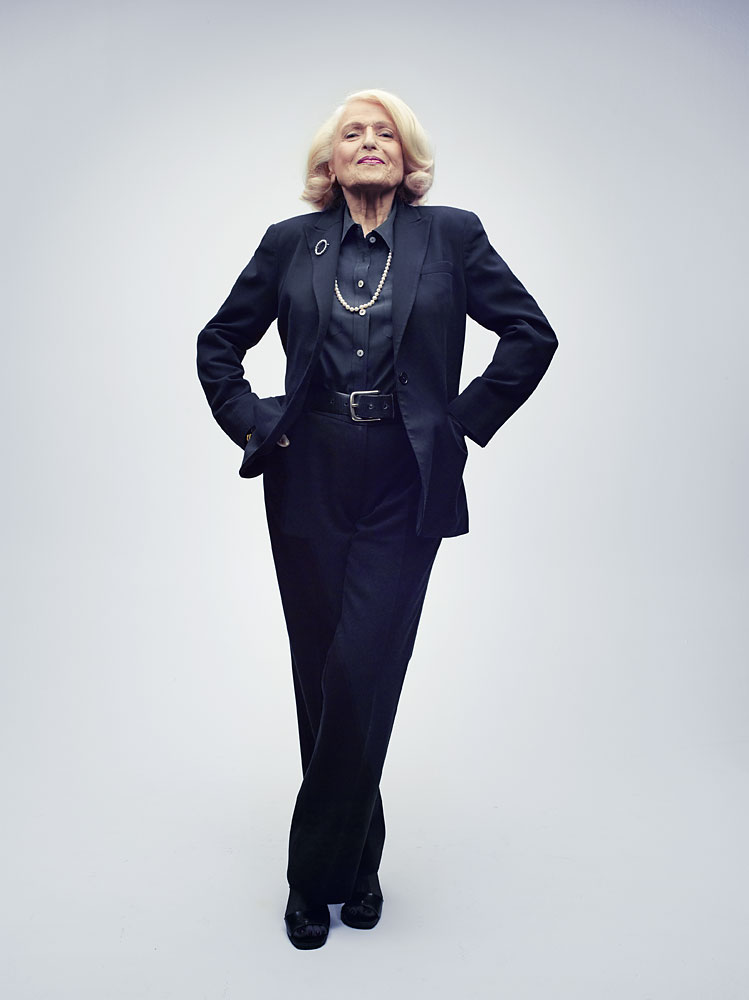Correction appended, Dec. 16, 2013
Edith Windsor’s living room is filled with mementos of a battle she never expected to wage. Growing up gay in America, Windsor, now 84, mostly kept a low profile with her sexuality beyond a vibrant circle of friends. But when her spouse Thea Spyer died in 2009, it triggered a series of events that prompted Windsor to fight for her rights in the U.S. Supreme Court—a fight that concluded with a landmark victory for gay marriage this year.
And so the modest Greenwich Village apartment that Windsor and Spyer shared for more than 30 years now houses trophies alongside relics of the rich life they led together. Near a framed copy of the couple’s New York Times wedding announcement, there’s a photograph of Michelle Obama stooping to give Windsor a tight congratulatory hug. From a pile of thank-you letters she has received, Windsor pulls out a note written in green felt-tip marker by Grace, age 9, thanking her for making it possible for her parents to marry. In her hallway is a piece of artwork with a note from lesbian cartoonist Alison Bechdel that reads, “For Edith! Thank you for paving the way.”

Windsor’s judicial odyssey began in 2010, when she sued the government for a $363,053 refund of the estate taxes she had to pay when her spouse died. Under the Defense of Marriage Act, a federal law passed in 1996, the couple’s legal marriage in Canada in 2007 didn’t qualify them for any federal protections, including the estate-tax exemption for surviving spouses. When the Supreme Court decided 5-4 in Windsor’s favor on June 26, it declared DOMA—which excluded gay married couples from some 1,100 federal provisions, like filing joint tax returns and accessing veterans’ benefits—unconstitutional. The decision marked the first time the U.S. recognized marriage between partners of the same sex. It was a big win.
Windsor now finds herself transformed into an icon of the gay-rights movement. She wears the mantle well. Feisty, funny and extroverted, Windsor has been, at different points in her life, a leader. At 13 she was elected vice president of her eighth-grade class. In the 1960s and early ’70s, after developing a precocious expertise in computer programming at IBM, she managed (at times reluctant) men. The homes she shared with Spyer in New York City and the Hamptons were salons for many people in the gay and lesbian community. The couple’s love and tenacity “empowered the rest of us as we were coming up,” says historian and friend Blanche Wiesen Cook.
But like almost all gay people in her generation, Windsor lived a double life. “Most of us have spent most of our lives coming out selectively. It’s safe here. It’s good here. You can say you have a wife here, but not there,” she says. Though she had always been quietly supportive in the gay community, generous with her time and money, she had not been—in the most literal meaning of the word—an activist.
Her case, of course, has changed that. “I can’t be more out,” she says joyfully.
A Happy Childhood
Edith Windsor, who has always been called Edie, was born in 1929, the youngest of three, to James and Celia Schlain, immigrants from Russia who owned and lived above a candy and ice cream store in a poor part of Philadelphia. When Windsor was 2, the store was quarantined after she and her brother got polio. Her parents lost the store and their house. Despite this, Edie was sheltered from the Depression—her father took a hard-boiled-egg sandwich to work every day for lunch so he could buy books, and little Edie read voraciously. (She still has in her apartment the 19-volume dictionary her father used to learn English.) She was not sheltered from anti-Semitism. Her mother taught her that if a boy called her “a dirty Jew,” she should pull his hair and run home.
The family moved to a middle-class neighborhood because her mother wanted her daughters to meet the right boys. Edie began high school during the war and had dates with boys “every Saturday night of my life.” Looking back, Windsor says, she had crushes on girls, but homosexuality wasn’t a concept she thought about or applied to herself then. “I didn’t even know about it,” she remembers. “The first time I became aware, I was at a [college] party with a boy and I was in the kitchen, and the hostess came in and said, ‘Do you have homosexual relations?’ And I pulled myself together, and I said, ‘On occasion.’ I never had.”
During her time in college, which she started in 1946, Windsor’s awareness grew. By chance, she was assigned to write a paper on the 1948 Kinsey report, which argued that homosexuality was more prevalent than previously thought. She fell in love with a girl—a classmate at Temple University—for the first time. “It was both wonderful and terrible,” she says. Their romantic relationship caused Edie to break off her engagement to a man. But then, deciding that she didn’t want to live life as a gay person, Edith reconciled with him. They eventually married. “In the context of the homophobia that was so prevalent in the 1950s,” she wrote in her sworn affidavit to the U.S. District Court for the Southern District of New York, “I certainly didn’t want to be a ‘queer.’ Instead, I wanted to live a ‘normal’ life.”

